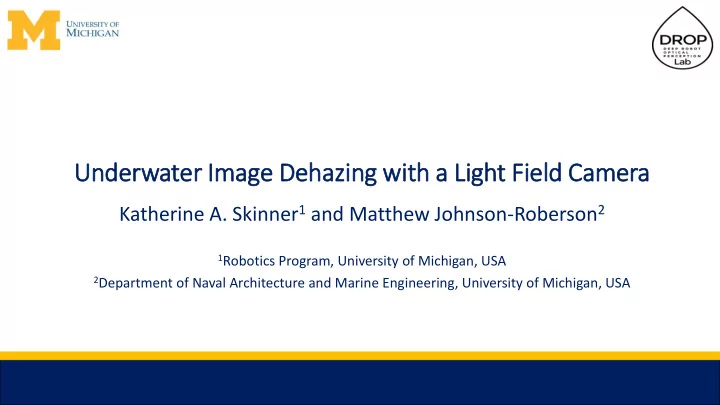

Underwater Im Image Dehazing wit ith a Li Light Fie ield Camera Katherine A. Skinner 1 and Matthew Johnson-Roberson 2 1 Robotics Program, University of Michigan, USA 2 Department of Naval Architecture and Marine Engineering, University of Michigan, USA
Motivation Photo: Volodymyr Goinyk 2
Motivation Lizard Island, Australia Port Royal, Jamaica 3
Motivation Photo: Jaffe Lab 4
Motivation Photo: Jordt (2014) 5
Light Field Cameras • Real-time RGB-D • Passive optical sensors • Compact form factor • Increased depth-of-field Photo: Raytrix Photo: Lytro 6
Real-time Underwater 3D Reconstruction Katherine A. Skinner and Matthew Johnson-Roberson, "Towards real- time underwater 3D reconstruction with plenoptic cameras .“ IROS, 2016 . 7
Real-time Underwater 3D Reconstruction Katherine A. Skinner and Matthew Johnson-Roberson, "Towards real- time underwater 3D reconstruction with plenoptic cameras .“ IROS, 2016 . 8
Pure vs. Turbid Water Disparity map in pure water Disparity map in turbid water 9
Underwater Image Restoration Contribution: We present a pipeline for dehazing of underwater light field images incorporating a physical model of underwater light propagation. 10
Underwater Light Field Image Dataset https://github.com/kskin/data Contribution: Provide a comprehensive light field dataset for underwater image dehazing. 11
Technical Approach 12
Dehazing Model 𝐽(𝒚) = 𝐾(𝒚)𝑓 −𝜃𝑒(𝒚) + 𝐵(1 − 𝑓 −𝜃𝑒(𝒚) ) 13
Dehazing Model 𝐽(𝒚) = 𝐾 𝒚 𝑢(𝒚) + 𝐵(1 − 𝑢 𝒚 ) 14
Dehazing Model 𝐽(𝒚) = 𝐾 𝒚 𝑢(𝒚) + 𝐵(𝒚) 1 − 𝑢 𝒚 +𝑀 𝛽 (𝒚) ∗ 𝑩𝑸𝑻𝑮 • Non-uniform illumination • Glow patterns Reference: Y. Li et al. “Nighttime haze removal with glow and multiple light colors”. ICCV 2015. 15
Synthesizing Views 16
Recovering Epipolar Images 17
Results In air Raw underwater Our result 18
Results Disparity map using raw underwater image Disparity map using corrected image 19
Conclusions • Presented an underwater light field image dehazing pipeline that incorporates a physical model of light propagation • Provided an underwater light field image dataset 20
Future Work • Gather light field images of more complex scenes • Greater depth disparity • Varying turbidity • Further leverage light field structure • All-in-focus filter [1] • Consistent motion between sub-aperture images • Incorporate more components of physical model for underwater light propagation • Recovering range in underwater imaging [1] Dansereau, et al. Light field image denoising using a linear 4D frequency-hyperfan all-in-focus filter. Computational Imaging, 34(2):15 – 1, 2013. 21
Final Thoughts Underwater light field camera – contact kskin@umich.edu Deep learning approach to underwater image restoration Honolulu, Hawaii 22
Recommend
More recommend